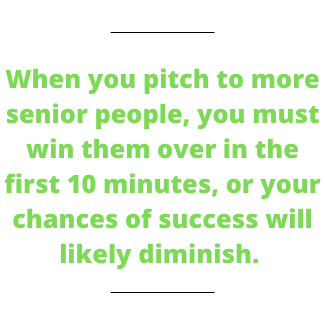How To Crush It With The Opening of Your Pitch

1dayreview.com
No one would claim that business development is glamorous. Filling out RFQs. Writing proposals in response to RFPs. Endless brainstorming meetings. Late nights, weekends, donuts, pizza, and maybe a few beers, even if you’re doing it via Zoom.
Yep, not glamorous. Except, maybe, for one part: the pitch.
We’ve seen versions of the pitch in countless movies and TV shows. Most of us have seen at least one episode of Shark Tank, which is nothing but pitches.
It’s certainly a vital part of any promotional products agency’s new business process. Yet as important as it is, too many agencies of all kinds plan and deliver very ineffective pitches. At The Artemis Partnership, we’ve heard too many sad tales of shops who seem to have the pursuit won until the final round, only to come out on the losing end.
Why do so many agencies make it to the finals often and then fail to convert, even when their promo ideas are terrific? We think it’s because they fail to recognize this fundamental truth about decision-makers: They’re human beings with predictable decision-making priorities. And agencies that lose in the final round don’t recognize–and leverage–these priorities.
Here’s what we mean.

The RFP Tells Only a Small Part of the Story
An RFP provides predictable, rational information. All of it is fundamentally true. The objectives stated in it need to be met. But that’s not nearly all that matters to decision-makers.
What RFPs don’t tell you is this: The hopes, dreams, vision, fears, challenges, concerns, obstacles, ambitions, and politics that drive or confront decision-makers? We call these emotional motivators. How are they viewing this brand or project and its associated promotional activities as addressing these motivators which never appear in RFPs?
So your pitch has to address these if you want to give yourself the best chance of winning. You’re already thinking, “How do I find this out?” It’s learnable. But not if your first or only point of contact with the prospect is via RFQ/RFP. Successful business development is actually a process that should start long before the RFP arrives. We regularly work with our clients on this vital area of business development.
Nevertheless, if you made it to the final round and have been asked to pitch, there’s an expectation that your product strategies and tactics can meet these motivators. So, you better do what you can to demonstrate it during the pitch.

As important as this last point is, there’s another prescription for winning pitches that might be even more crucial. It’s not the “what” of your pitch. It’s the “when.”
You Have 10 Minutes to Win—Or Lose
While we’re talking about the human nature of decision-makers, here’s another thing to consider. When you pitch to more senior people, you must win them over in the first 10 minutes, or your chances of success will likely diminish.
There are dozens of analyses of thought processes, both inside and outside the business context. It’s quite clear that all of us tend to leap to conclusions in relatively short time. (The best description of this that I’ve come across is Daniel Kahneman’s Thinking Fast and Slow.) It’s also clear that senior decision makers are more likely to have “driver” or “expressive” business communication and business thinking styles. This means that they make business judgments quickly.
So, when they’re sitting in a real or virtual meeting room, and they’re listening to five or more promotional products agencies make their pitch, they’re not waiting for you to get through your credentials, the review of objectives, the discussion of your process, the results of your research, and the range of options you considered before you get to your recommendation.
Based on our extensive experience, we think they’ll give you about 10 minutes to prove that you’re the right firm with the right idea. After that, they’ve made up their mind. The rest of your pitch will only confirm the conclusion they’ve already reached.
What’s the best way to address this 10-minute issue? You’ll find your best path as we discussed in the previous section. Find out what really matters to the decision makers and drive that home. Even if you don’t know for sure, here’s a formula that’s built for senior-level decision-makers:
Here’s the challenge (or opportunity or vision). And here’s what our promotional strategy or device will do about it on your behalf.
Most notable for some of you will be what’s not in the first 10 minutes. No more lengthy team introductions. Or credentials of your agency. Or recitation of the objectives and parameters that were published in the RFP. Or discussion of your process.
I’m not suggesting the rest of your pitch content isn’t important. Of course it is. But if decision-makers don’t pay attention to it because you haven’t given them enough reason to in the first 10 minutes, then it didn’t have the impact you intended. A strong opening sets the stage for a strong pitch and a big win.
Bob Wiesner is managing partner, Americas, of The Artemis Partnership, a global consultancy focused on helping its clients improve the results of their business development efforts. Wiesner has been working in this area for over 25 years. He’s the author of Winning Is Better: The Journey to New Business Success.

